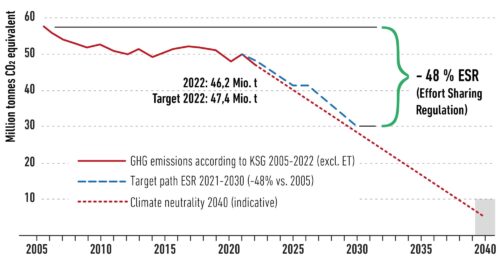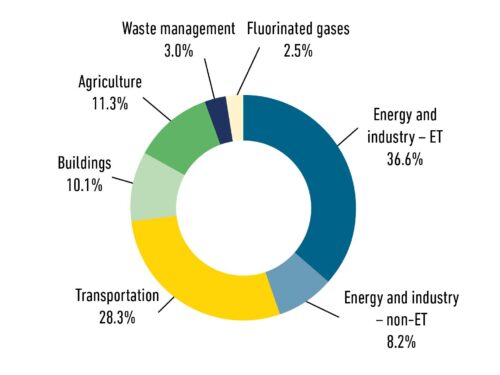Achieving the national goal of “climate neutrality by 2040” requires that both the economy and society undergo comprehensive transformation processes. Austrian industry will play a central role in achieving this goal as industrial production, together with the energy sector, accounts for the largest share of climate-damaging greenhouse gas emissions. The greenhouse gas emissions of these two sectors amounted to 32.6 million tonnes of CO2 equivalent in 2022, which corresponds to around 45% of total emissions (72.84 MT CO2 equivalent) in Austria.1
Industry also consumes the largest share of energy. A total of 110 TWh of energy is required annually to power all the plants and processes at industrial sites in Austria. This accounts for around 27% of gross domestic consumption.2 On the other hand, industry is an important driver of sustainable growth, jobs, innovation and quality of life in Austria. According to Statistics Austria, “industry and construction” include manufacturing, mining, energy and water supply as well as the construction industry, and with a share of around 29% of gross domestic product (GDP), this sector makes a significant contribution to Austria’s economic output, employing almost one million people in over 67,000 companies.3
The transformation towards clean, resource-efficient and competitive production is one of the biggest challenges on the path to climate neutrality. Research and technology development play a central role here. Important starting points for the transformation process in industry are the topics of resources, energy, CO2 and the circular economy.


Shaping the transformation process
In recent years, great progress has been made in the development and demonstration of innovative technologies and concepts for the decarbonisation of industry. The task now is to integrate these into industrial processes in order to produce high-quality and competitive products in the long term. Back in 2020, the Federal Ministry for Climate Action, Environment, Energy, Mobility, Innovation and Technology (BMK), in cooperation with the Federation of Austrian Industries, launched the dialogue process “Climate-neutral industry in Austria”. The goal here was to enter into active dialogue with the largest Austrian industrial companies, discuss approaches for transforming the industry and develop corresponding strategies.
www.bmk.gv.at/themen/klima_umwelt/gruene-industriepolitik/klimafitte_industrie.html
The current study transform.industry conducted by the Austrian Institute of Technology (AIT) on behalf of the Climate and Energy Fund4 addresses the question of how best to approach the process of decarbonising industry. In four scenarios applied to 13 industrial sectors, potential development paths were examined based on various decarbonisation measures and technologies.
In the “renewable gases” scenario, the sustainable transformation of industry is achieved by switching from fossil fuels to renewable energy sources. The “innovation” scenario entails a strong focus on implementing the best available solutions and breakthrough technologies, while the “sector coupling” scenario aims at utilising energy carriers as efficiently as possible, for example by using waste heat from industrial processes in other sectors. The “circular economy” scenario is based, among other things, on increased material efficiency and high recycling rates, which reduces the energy-intensive production of basic materials. All these scenarios clearly show that the expansion of renewable energy must be a top priority in the coming years. In order to drive forward the decarbonisation of industry, companies also need planning security, faster approval procedures and ongoing technological development. The analyses show that all four scenarios have a positive effect on economic growth. According to the calculations, the transformation will generate additional GDP growth of around EUR 8 to 10 billion. Roadmaps for strategic research, technology and innovation as well as corresponding recommendations for action were developed based on the results.
www.klimafonds.gv.at/mediathek/studienpraesentation-transform-industry
Podcast of the Austrian Energy Agency on the study:
www.petajoule.podigee.io/62-transformindustry
Focus on the circular economy
The concept of the circular economy is a key solution for conserving energy and resources as well as avoiding climate-damaging emissions in industrial production. Significant impetus for researching and implementing this concept was generated by the adoption of the Circular Economy Strategy 2022 and the BMK’s RTI focus on the circular economy, which was established in 2021 and is also explicitly addressing production technologies as of 2024 (see pages 4-5). In this issue, we present some Austrian RTI projects that are developing and demonstrating innovative solutions for the transformation of industry with a focus on the transition to a circular economy.
The federal government’s climate and transformation campaign supports Austrian industrial companies in making their production processes climate-neutral. On the one hand, this strengthens value creation in Austria, and on the other, it leads to greater independence from fossil fuel imports. Funding totalling around EUR 5.7 billion will be available until 2030, of which EUR 320 million will go to the RTI initiative “Transformation of Industry”. This initiave is implemented by the Climate and Energy Fund and supports the development and demonstration of innovative technologies that contribute to climate protection and sustainability and increase the competitiveness of the Austrian economy.
www.bmk.gv.at/themen/klima_umwelt/klimaschutz/ufi/industrie.html
www.klimafonds.gv.at/call/fti-initiative-fuer-die-transformation-der-industrie-zweite-ausschreibung
1 Source: www.klimadashboard.at/emissionen, total emissions Austria 2022: 72.84 MT CO2 eq, industry share: 34.44% based on the CRF dataset of the Environment Agency Austria (data including 2022, open data)
2 Source: Study “Climate neutrality in Austria by 2040 – Contribution of Industry” (AIT, EVT, Energy Institute JKU Linz, Austrian Energy Agency)
3 Source: IV, www.iv.at/-en-/Austrian-Industry/austrian-industry.html
4 Project partners: Austrian Energy Agency, University of Leoben, Energy Institute at Johannes Kepler University Linz
